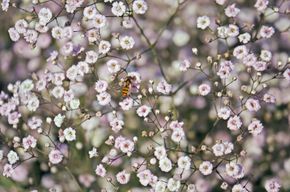Their light, airy texture and petite white or pink flowers make baby's breath a wonderful addition to the garden. This annual is native to the Caucasus and is related to carnations. Because they bloom for only 6 weeks, new seedlings should be started to replace those that have finished blooming.
Description of baby's breath: Annual baby's breath grows to 11/2 feet tall, forming an airy bush with many forked branches covered with flowers. Although the flowers, up to 1/2 inch in diameter, are usually white, there are pink, rose, and carmine forms.
Advertisement
Growing baby's breath: Grow in full sun in average, lime-rich garden soil. They grow rapidly and will come into bloom about 8 weeks after germination. Sow new baby's breath every 2 to 4 weeks to assure continuous bloom for the summer.
Propagating baby's breath: By seed. Sow seeds outdoors in place after the danger of frost has passed. For earlier bloom, sow indoors in peat pots 2 to 3 weeks before planting out, then plant -- pot and all. (They grow so rapidly, it is difficult to separate the seedlings, so plant them in a clump.) Germination takes 10 to 15 days at 70 degrees Fahrenheit.
Uses for baby's breath: Baby's breath is effective in borders or cottage gardens. Baby's breath also makes a superb cut flower. It is used primarily as a filler to give unity to arrangements with strong vertical or horizontal lines.
Baby's breath related species: Gypsophila paniculata is a perennial and widely planted. Both single- and double-flowers are found, with Bristol Fairy the most popular species. Gypsophila muralis is a mounding species native to Europe. Garden Bride has light pink flowers. Gypsy is a pink double.
Baby's breath related varieties: The favorite white is Covent Garden, which is also the favorite cut flower strain. Kermesina is a deep rose. Red Cloud has shades ranging from pink to carmine. Mixtures of rose, white, and red are also available.
Scientific name of baby's breath: Gypsophila elegans
Advertisement
